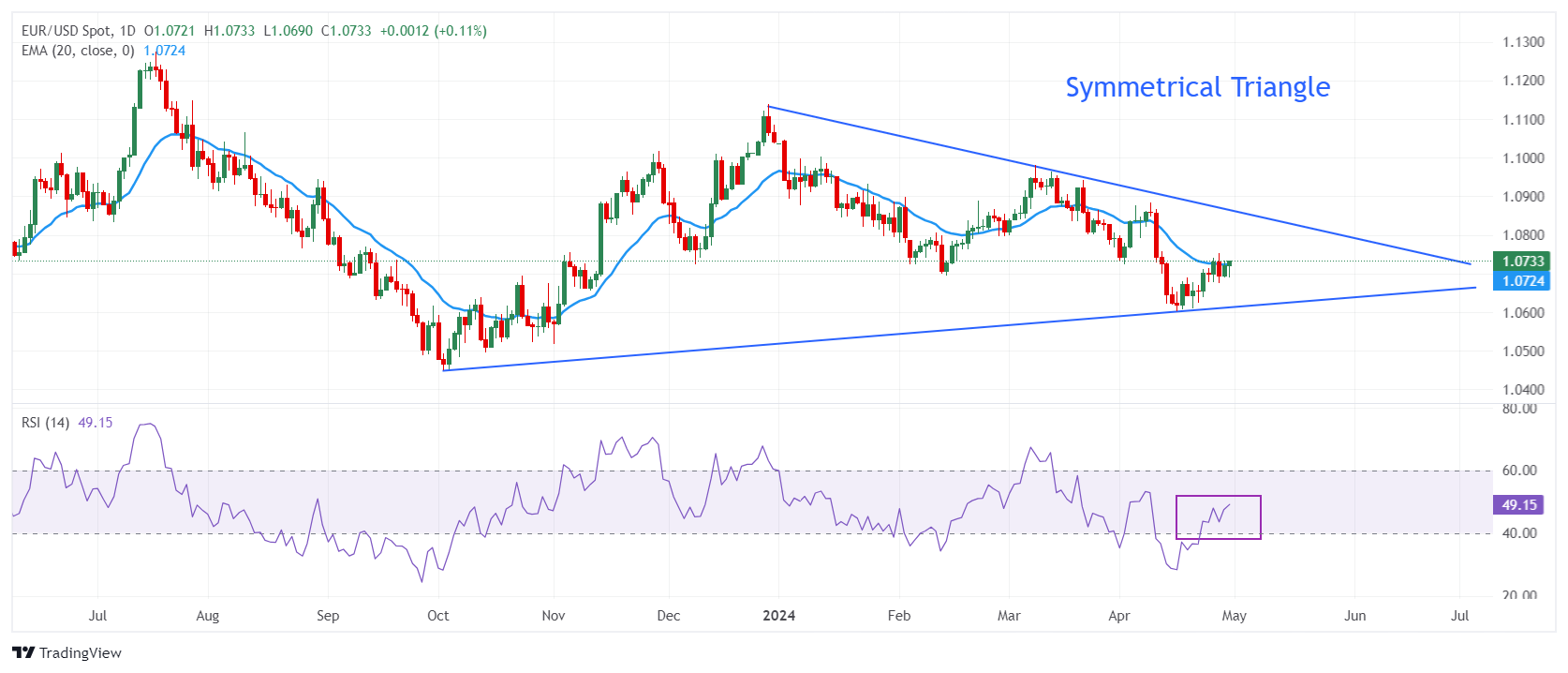- EUR/USD loses intraday gains and falls to 1.0700 following strong US Q1 Labor Cost Index numbers.
- The high inflation in the Eurozone and the strong GDP growth in the first quarter fail to give a sustainable boost to the Euro.
- US Dollar expected to hold firm amid caution ahead of Fed policy decision.
EUR/USD reverses intraday gains and falls to crucial support at 1.0700 in early US session. Euro fails to maintain gains driven by strong Eurozone data against US Dollar after after the US Bureau of Labor Statistics (BLS) reported strong growth in the first quarter employment cost index.
The data, a leading indicator of wage growth, grew at a strong pace of 1.2% compared to estimates of 1.0% and the previous reading of 0.9%. This has heightened fears that US inflation will remain stubbornly on the rise, as strong wage growth translates into strong household spending, which ends up fueling price pressures.
In the Eurozone, preliminary inflation data for April and Gross Domestic Product (GDP) for the first quarter have beaten the consensus. On an annual basis, the Harmonized Index of Consumer Prices (HICP) rose firmly and met estimates, while the core HICP, which excludes food and energy prices, softened at a slower pace.
The eurozone economy grew by 0.3% in the first quarter, despite the fact that the European Central Bank (ECB) maintains the interest rate on its main refinancing operations at historical highs of 4.5%.
The fact that the Euro failed to maintain gains following the release of key economic indicators suggests that investor confidence in the ECB pivoting to interest rate cuts from June remains intact. Speculation continues that the ECB will cut interest rates from June, as most ECB policymakers have also supported a rate cut. Some consider that the rate lowering campaign will extend to the following meetings this year.
Daily Market Moves Summary: EUR/USD Fails to Maintain Gains Following High US Q1 Labor Cost Index Figures
- EUR/USD retreats to crucial support at 1.0700 following Eurozone Q1 inflation and GDP data. Eurostat reported that inflation remained almost stable in April and first quarter GDP exceeded estimates. Eurozone headline inflation rose in line with consensus and the previous reading of 2.4%. Annual core inflation, which strips out food and energy price volatility, rose 2.7%, above estimates of 2.6%, but slowed from the previous reading of 2.9%. .
- Headline and core monthly inflation increased by 0.6% and 0.7%, respectively. The Eurozone economy grew at a strong pace of 0.3% in the 1st quarter, exceeding expectations of 0.1% and stagnation in the last quarter of 2023. On an annual basis, the first quarter GDP growth rate was double the expectations of 0.2%.
- The stability of preliminary inflation in April, combined with strong GDP growth in the first quarter, is less likely to affect expectations of rate cuts by the European Central Bank, which financial markets expect to begin in June.
- On the other side of the Atlantic, the US dollar recovers amid caution ahead of the Federal Reserve's monetary policy decision, which will be announced on Wednesday. The US Dollar Index (DXY) recovers from 105.50 but remains within the two-week trading range of 105.40-106.50. The Fed is expected to keep interest rates unchanged in the 5.25%-5.50% range for the sixth consecutive time, as price pressures in the United States remain stubbornly bullish due to strong wage growth.
- The Fed is likely to support keeping interest rates at their current level for longer, until it gains greater confidence that inflation will sustainably return to the desired 2% target rate. Investors will be watching to see if the Fed sticks to its forecast for three rate cuts this year, captured in the March dot chart.
- Aside from Wednesday's Fed decision, investors will also focus on the US ADP employment change and the April ISM manufacturing Purchasing Managers' Index (PMI) report.
Technical Analysis: EUR/USD Looks Vulnerable Above 1.0700

The EUR/USD pair struggles to hold firm above the 1.0700 round level support. The major currency pair is struggling to break above the 20-day EMA, which is trading around 1.0725.
The overview of the EUR/USD pair indicates a sharp contraction in volatility due to the formation of a symmetrical triangle on the daily time frame. The ascending edge of the triangle is drawn from the October 3 low at 1.0448 and the descending edge is drawn from the December 28 high around 1.1140.
The 14-period RSI is moving into the 40.00-60.00 range, suggesting indecision among market participants.
Risk Sentiment FAQ
What do the terms “risk-on” and “risk-off” mean when referring to sentiment in financial markets?
In the world of financial jargon, the two terms “risk appetite (risk-on)” and “risk aversion (risk-off)” refer to the level of risk that investors are willing to bear during the investment period. reference. In a “risk-on” market, investors are optimistic about the future and are more willing to buy risky assets. In a “risk-off” market, investors begin to “play it safe” because they are worried. for the future and, therefore, buy less risky assets that are more certain to provide a return, even if it is relatively modest.
What are the key assets to follow to understand risk sentiment dynamics?
Typically, during periods of “risk appetite”, stock markets rise, and most commodities – except gold – also appreciate as they benefit from positive growth prospects. The currencies of countries that are large exporters of raw materials strengthen due to increased demand, and cryptocurrencies rise. In a “risk-off” market, Bonds – especially major government bonds – rise, Gold shines and safe-haven currencies such as the Japanese Yen, Swiss Franc and US Dollar benefit.
Which currencies strengthen when sentiment is “risk-on”?
The Australian Dollar (AUD), Canadian Dollar (CAD), New Zealand Dollar (NZD) and minor currencies such as the Ruble (RUB) and the South African Rand (ZAR) tend to rise in markets where there is “appetite for risk.” This is because the economies of these currencies rely heavily on commodity exports for their growth, and these tend to rise in price during periods of “risk appetite.” This is because investors anticipate higher demand for raw materials in the future due to increased economic activity.
Which currencies strengthen when sentiment is “risk averse”?
The major currencies that tend to rise during periods of “risk aversion” are the US Dollar (USD), the Japanese Yen (JPY) and the Swiss Franc (CHF). The Dollar, because it is the world's reserve currency and because in times of crisis investors buy US public debt, which is considered safe because it is unlikely that the world's largest economy will go into default. The Yen, due to the increase in demand for Japanese government bonds, since a large proportion is in the hands of domestic investors who are unlikely to get rid of them, even in a crisis. The Swiss franc, because strict Swiss banking legislation offers investors greater capital protection.
Source: Fx Street
I am Joshua Winder, a senior-level journalist and editor at World Stock Market. I specialize in covering news related to the stock market and economic trends. With more than 8 years of experience in this field, I have become an expert in financial reporting.







